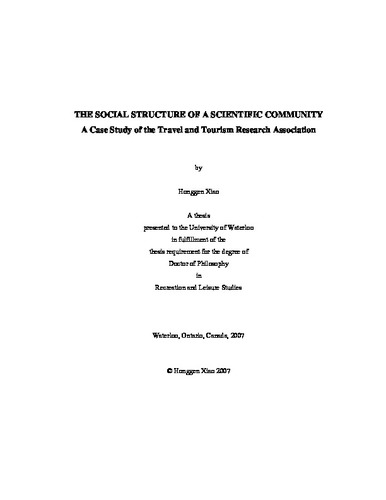UWSpace will be migrating to a new version of its software from July 29th to August 1st. UWSpace will be offline for all UW community members during this time.
The Social Structure of a Scientific Community: A Case Study of the Travel and Tourism Research Association
| dc.contributor.author | Xiao, Honggen | |
| dc.date.accessioned | 2007-12-07 16:49:28 (GMT) | |
| dc.date.available | 2007-12-07 16:49:28 (GMT) | |
| dc.date.issued | 2007-12-07T16:49:28Z | |
| dc.date.submitted | 2007 | |
| dc.identifier.uri | http://hdl.handle.net/10012/3437 | |
| dc.description.abstract | The applied tourism research community is characterized by a large and growing group of research producers and users; communications and networking amongst its members can build the capacity of the community and create knowledge networks along its social, cultural, and organizational boundaries. The purpose of this thesis research is to examine the role of tourism research associations in the social structuring of a cohesive applied research community and, consequently, in the fostering of its growth. Following an embedded single case design, the study uses the Travel and Tourism Research Association (TTRA hereafter) as an example of an applied tourism research community. The research examines members’ perceptions of the association in the capacity-building of the membership community through research communications and professional networks. Based on documentary sources, an instrument was developed for primary data collection through an online census of TTRA members. Data collection was completed in the Spring of 2007, with a response rate of 28.7%. Data analysis is guided by hypothesis, with results of the case study described and discussed in the contexts of research communications, knowledge networks, scientific community, and research association planning and management. First, with respect to research communication, a number of social demographic factors are found to have exerted an impact on media use frequencies and decisions, and perceptions of research communication in the membership community. Notably, these include members’ occupations, career stages, membership categories, and research-oriented training. The chapter structure of TTRA does not affect members’ behaviour in research communication. However, the study confirms a distinction between academics and practitioners and lends support to discussions on the two-community theory concerning cultural and functional differences in producing and consuming research. The study also finds that TTRA-endorsed media are of limited use in the membership community for professional communication. In addition, association members form distinct clusters by the frequency and variety of information sources they have consulted for research communication. Second, in terms of networks or networking amongst TTRA members, types and extent of member interactions are influenced by members’ occupations, in particular whether the member is an academic or practitioner. Professional networks are formed on the basis of research interests and expertise; so are the perceptions of research networks and the perceived role of TTRA in professional networking affected by gender, career stage, membership positions, and disciplinary and research-oriented preparations. The study finds that the strengths of ties amongst members are both causes and consequences of the size of a community or network. TTRA is generally perceived as becoming too academic and, in light of this, the association is seen as an important facilitator of scholarly networks. Nonetheless, the association community is characterized by pro-academic and pro-practitioner clusters in terms of membership perceptions of research networks and their attitudes towards networking. In addition, while chapter affiliations do not have an impact on network perceptions and behaviour, results from this study point to the facilitator role of association conferences for research communication, professional networking and association capacity-building. Third, the facilitator role of the association for community capacity-building is widely acknowledged by its members. Respondents see professional networking and association conference venue as particularly important factors in attracting attendance from the membership community. The study confirms the essential role of conferences in building a sense of community for a research association. There is a considerable degree of consensus amongst members on their perceptions of TTRA as a community. Homogeneous clusters are formed by membership perceptions of a community and their willingness or engagement in community service provisions. Conceptually, the clusters developed around (or for) research communication, networking and association capacity-building are highly consistent in terms of pattern matching in case study analysis. The research has also discussed theoretical and practical implications, some of which are expressed as recommendations for association planning and management. The study concludes with reflections on limitations and prospects for future inquiries. | en |
| dc.language.iso | en | en |
| dc.publisher | University of Waterloo | en |
| dc.subject | scientific community | en |
| dc.subject | research communication | en |
| dc.subject | knowledge networks | en |
| dc.subject | tourism research and scholarship | en |
| dc.subject | tourism as an applied research community | en |
| dc.subject | Travel and Tourism Research Association | en |
| dc.title | The Social Structure of a Scientific Community: A Case Study of the Travel and Tourism Research Association | en |
| dc.type | Doctoral Thesis | en |
| dc.pending | false | en |
| dc.subject.program | Recreation and Leisure Studies | en |
| uws-etd.degree.department | Recreation and Leisure Studies | en |
| uws-etd.degree | Doctor of Philosophy | en |
| uws.typeOfResource | Text | en |
| uws.peerReviewStatus | Unreviewed | en |
| uws.scholarLevel | Graduate | en |

